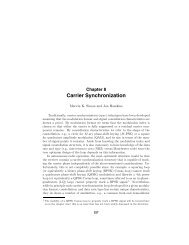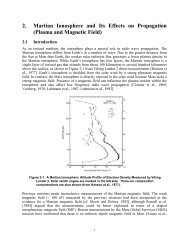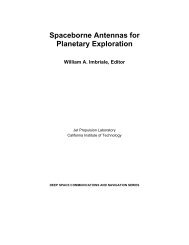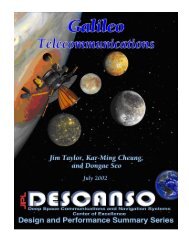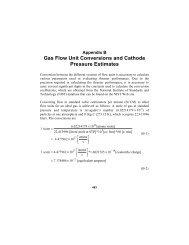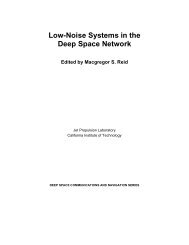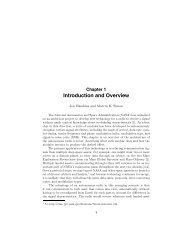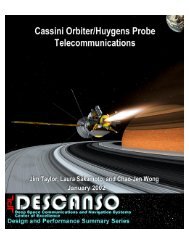Propagation Effects Handbook for Satellite Systems - DESCANSO ...
Propagation Effects Handbook for Satellite Systems - DESCANSO ...
Propagation Effects Handbook for Satellite Systems - DESCANSO ...
You also want an ePaper? Increase the reach of your titles
YUMPU automatically turns print PDFs into web optimized ePapers that Google loves.
9<br />
electrostatic fields discharge rapidly resulting in” rapid relative<br />
phase shifts of 180°, and rapid decreases in XPD of 27 dB in 20<br />
seconds (Shutie~ et al-1977)’ have been observed at the occurrence of<br />
a lightning flash. An example of this is shown in Figure 6.6-8<br />
where the spikes in the relative phase occur <strong>for</strong> increasing XPD and<br />
result in large phase changes.<br />
The spectra of rain and ice-induced crosspolarized signals have<br />
been analyzed (Hayworth, et al-1977) and it appears that a<br />
cancellation system with a 10 Hz bandwidth would track the majority<br />
of depolarizing events. However this bandwidth is probably<br />
-.<br />
insufficient during the sudden realignment of ice crystals in<br />
\ thunderstorms and in nonelectrically active precipitation. A<br />
suggestion has been made to consider use of a dual time constant<br />
system to accommodate all likely events.<br />
For ice crystal depolarization the crosspolar phase shift is<br />
usually *9O degrees of the copolarized signal and so differential<br />
attenuation dominates the XPD variations. This effect was displayed<br />
in Figure 6.6-6. However depending on the frequency, rain-induced<br />
XPD variations predominantly shift the phase near 20 GHz and below<br />
and induce differential attenuation from 20 to 60 GHz (Hogg and Chu-<br />
1975).<br />
6.6.3.3 CCIR Estimation <strong>for</strong> Ice Depolarization. The CCIR (1986b,<br />
Rpt . 564-3) has provided an empirical factor, Cice(p)t <strong>for</strong> estimatin9<br />
the contribution of ice deplarization at the percent of time p in<br />
terms of XPDrain(p)t the cross polarization caused by rain. The<br />
resulting rain + ice XPD at the percent of time p~ XPDT(P)# is then<br />
determined from:<br />
where,<br />
XPD~ (p)<br />
Ci,, (P)<br />
= XPD,,i~(P) - CiC,(P)<br />
0.3 + 0.1109 10 P<br />
= 2<br />
6-119<br />
xpDrain(p)<br />
,in dB<br />
(6.6-4)<br />
(6.6-5)





